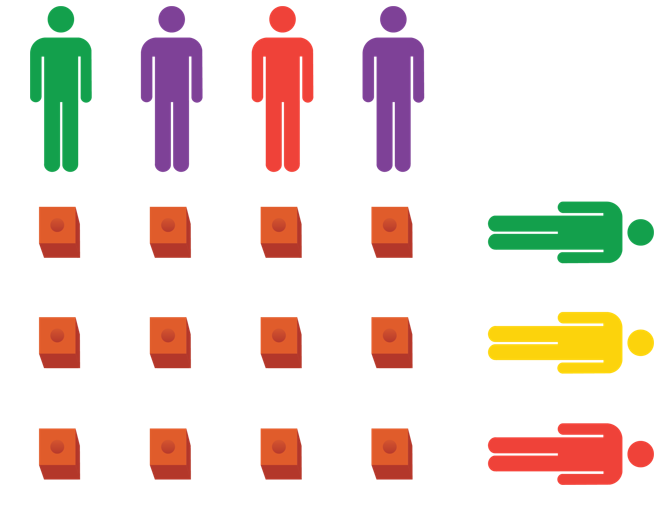Purpose
The purpose of this activity is to support students applying their knowledge of the relationship between multiplication and division when solving equal sharing problems. Students work with simple multiplication facts, such as multiples of two, five, ten and three.
Achievement Objectives
NA3-1: Use a range of additive and simple multiplicative strategies with whole numbers, fractions, decimals, and percentages.
NA3-2: Know basic multiplication and division facts.
Required Resource Materials
- Individual objects of interest and relevance to students. This lesson uses connecting cubes
- A calculator.
Activity
- Challenge students to apply the commutative property of multiplication to equal sharing situations, and to create division and fraction equations.
- Begin with a simple multiplication example. An array model can support students to see connections.
I have four groups of three cubes. How many cubes do I have altogether? (4 x 3 = 12)
If I share 12 cubes among four people, how many cubes does each person get? (12 ÷ 4 = 3)
If I share 12 cubes among three people, how many cubes does each person get? (12 ÷ 3 = 4) - Record equations for each situation: 4 x 3 = 12 and 3 x 4 = 12 (multiplication); 12 ÷ 4 = 3 and 12 ÷ 3 = 4 (division).
- Pose another simple multiplication example and model it with an array model. Ask students to help you come up with a story (either using cubes or a set of other, more relevant items) to frame the multiplication in. Focus on identifying all possible multiplication and division equations and encourage students to rely more on their basic facts knowledge, rather than on their use of materials. Use a calculator to model and confirm expressions.
- I have five groups of three cubes. How many cubes do I have altogether?
If I share 15 cubes among five people, how many cubes does each person get?
If I share 15 cubes among three people, how many cubes does each person get? - Record equations for each situation: 5 x 3 = 15 and 3 x 5 = 15 (multiplication); 15 ÷ 5 = 3 and 15 ÷ 3 = 5 (division).
- Introduce the te reo Māori kupu for divide/division (whakawehe) and multiply/multiplication (whakarea) if appropriate to your students' knowledge.

- Pose further examples, that call on a wider range of basic facts that are known to your students, to emphasise the links between the commutative property of multiplication and the solving of equal sharing problems. Focus on identifying all possible multiplication and division equations and encourage students to rely more on their basic facts knowledge, rather than on their use of materials. Use a calculator to model and confirm expressions.
- Allow students to work in groupings that will encourage peer scaffolding and extension. Some students might benefit from working independently, whilst others might need further support from the teacher. Consider also the different means of action and expression (e.g. verbal, written, digital, physical) that your students might use to demonstrate their thinking.
- Confirm students strategies and calculations before progressing to working with stories and equations without the support of physical models. You might call on a context that is relevant to your students' cultural backgrounds, interests, or learning from other curriculum areas to make these problems more engaging. Use questioning to emphasise the relationship between multiplication and division. For example:
What is the equation for this story?
What equal sharing problems can you solve from this multiplication fact?
Write division and fraction equations for the equal sharing problems.
Next steps
- Increase the level of abstraction by using diagrams without visible numbers of cubes, then progressing to stories and equations only.
- Ask anticipatory questions like, “if I know 3 x 8 = 24, what equal sharing problems can I solve?”
- Extend the problems that can be solved to include related facts. Students may recognise connections in multiplication situations but not transfer their knowledge to equal sharing. For example:
If you know 4 x 5 = 20, you also know 20 ÷ 4 = 5 and 20 ÷ 5 = 4.
If you know 4 x 5 = 20, do you know 4 x 6 = □?
If you know 4 x 6, what division problems can you solve?
Add to plan
Level Three